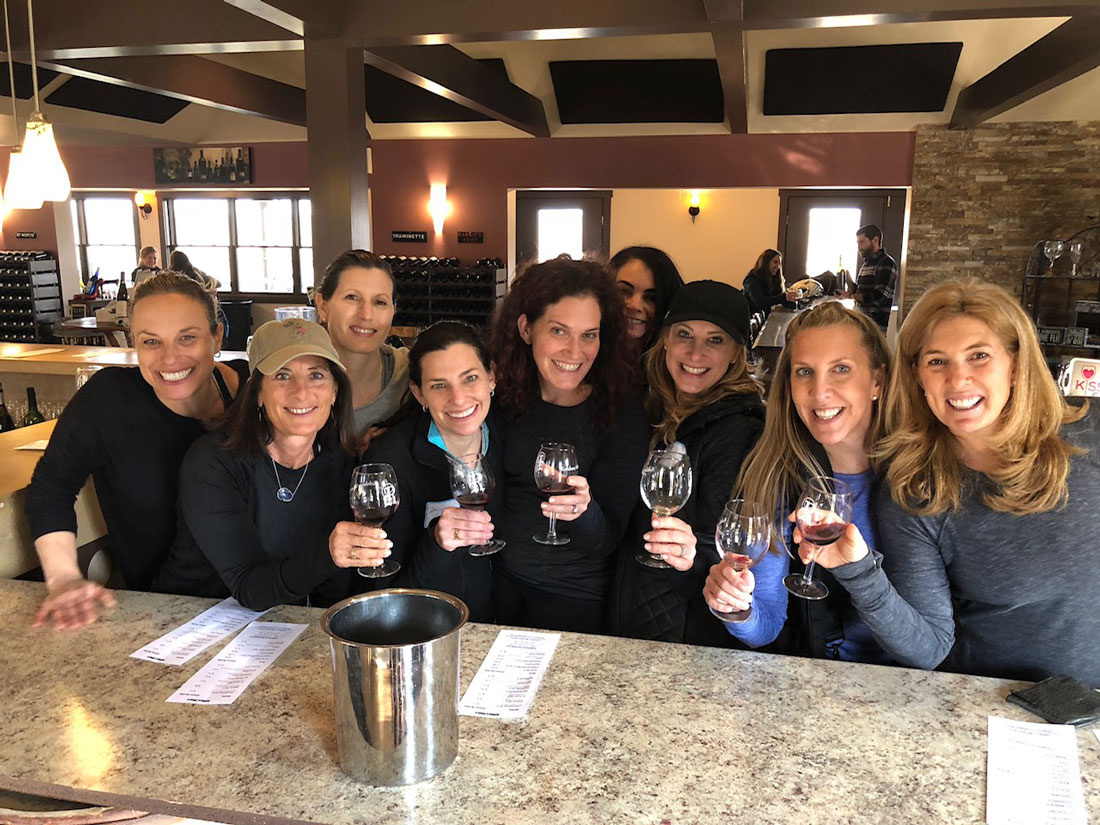
LJF Wine Tasting 101 – How To Taste Wine Properly

Do Wine tastings intimidate you?
You see others swirling their glass, looking deeply into the wine like they are looking for profound answers in life? Then they sip it, stop and think, sip some more and then either nod in approval or disapproval noting terms like tannins, crisp, dry finish, oaky…. While this is typically the way a tasting goes, let’s break it down step by step for you so you feel more like a Wine Connoisseur on your next Live Journey Fit Adventure!
There are 4 S’s when it comes to wine tasting – See. Smell. Swirl. Sip. Let’s begin, shall we?!

1. See:
Examine your wine. The first step in tasting a wine happens before you actually taste the wine. When the wine is first poured into your glass — before swirling it, smelling it, or sipping it — just look at it. The reason you look at the wine is to get a sense of its color, as a wine’s color can tell you a lot about the wine you’ll be drinking.
So why do we care about color? The first thing to remember is that the color of a wine comes from contact with the grape skins after the grapes have been juiced. The longer the wine comes in contact with those skins, the more those skins will impart their color on the wine.
Let’s Start With White Wines:
Light and bright white wines that you can see through have had minimal contact with the grape skins and are usually crisp and refreshing, like lemonade on a hot summer day. Typically, these wines have not been aged in an oak barrel.
If the wine is darker and deeper in yellow, then this is usually a good sign that the wine was aged in an oak barrel. It will have a smoother taste and will be much fuller and richer.
Now Let’s Look At Red:
Start by looking at the shade of red wine in your glass If the wine is light red, even approaching pink, it should taste light and bright. It may even be a little tart or “fresh” tasting and that is because the lighter the red of a wine, the less likely that it was ever aged in oak, and oak is what helps round and mellow a wine.
As the hue of the red wine gets darker and darker, approaching the colors of maroon and purple, the red will become much bolder and richer. These types of red wine are the ones you think of when you think red wine and steak dinner, and the darker and deeper the color, the longer they’ve spent aging in an oak barrel.

2. Swirl
Once you’ve looked at the wine in your glass and determined what the color means, the next step in tasting is to swirl and agitate the wine.
Everyone has their own unique technique for swirling wine, and that’s OK. Some people leave the bottom of the wine glass firmly planted on the table and just make a few circles with the base, while others like to pick the wine glass up and slightly flick their wrist, thereby making little circles in the air. Finally, others like to be extremely showy with their swirling, making grandiose motions like they’re getting ready to lasso a steer (we’d suggest avoiding this final type of swirling — it can be seen as obnoxious to your fellow drinkers).
No matter how you swirl the wine, your technique is completing an important next step in the tasting process: getting more oxygen into the wine. Oxygen is a friend and also an enemy of wine— frenemy. In the beginning, oxygen is really great for a wine because as soon as a wine encounters oxygen, it begins to break down, which most people refer to as a wine “opening up.” As the wine opens, it gives off its aromas and also softens, which is good. But if you let a wine sit in a glass exposed to oxygen for too long, say overnight, the oxygen will fully oxidize the wine, ruining it and leaving it with an unpleasant taste that can be flat and even bitter.
If you want to practice swirling, pour some water in a wine glass and try different techniques, swirling the water around for about 5 – 10 seconds. We like using water to practice because it helps avoid stains if you happen to slosh a little wine out of the glass at first. Once you get the hang of this tasting step, you’ll probably find yourself swirling all sorts of beverages out of habit!

3. Smell
When you smell a wine, you’re preparing your brain for the wine you’re about to taste. Our sense of smell has a profound effect on the way our brain processes flavor. If you want to better understand just how profound, hold your nose and then put a strawberry in your mouth and start to chew. Halfway through chewing, release your nose. You’ll notice right away how much more you actually taste when you have your sense of smell. This is why smell is so important when it comes to tasting a wine.
When you go to smell the wine, stick your nose all the way into the glass and close your eyes — sure you might feel silly doing it, but you’re going to notice a lot more smells this way — then breathe in deep. As you smell the wine, think about what scents you’re picking up, and keep in mind that there are no wrong answers! If it’s a white wine, maybe you smell bananas, lemon rind, pineapple or even that scent that is always in the air when you go to the beach.
If it’s a red wine, you may smell prunes, cherries, strawberries, peppers, plums or tobacco. In both situations, you may say you just smell grapes, and that is totally fine too. Your brain can only pick up scents that are in your memory, meaning they are scents you’ve smelled before or smell often. That’s why ten people could be sitting around a table smelling the same wine and say they smell ten different things!
Aromas:
• Grape Derived: include fruit-driven, herbal, and floral notes.
• From Winemaking Practices: The most common aromas are yeast-derivative and are most easy to spot in white wines: cheese rind, nut husk (almond, peanut), or stale beer.
• From Aging: Usually in a bottle, or possibly in oak. These aromas are mostly savory: roasted nuts, baking spice, vanilla, autumn leaves, old tobacco, cured leather, or mushroom.

4. Sip
Congratulations, you’ve made it to the big payoff. You’ve looked, swirled and smelled, so now it’s time to sip your wine.
Take a sip from your glass and let the wine sit in your mouth for a moment. At this stage, some people like to swish the wine around in their mouth, like they’re using mouthwash. They’re doing this so the wine touches all of their taste buds, but it’s not necessary. The main idea here is to let the wine linger in your mouth so that you take a moment to think about it. What does it taste like? Do you taste any of the smells you picked up? Is the wine drying your mouth out? (if this is happening, it means that the wine is strong in tannins) Then swallow.
If you’re tasting with others, talk about the wine. Be confident in what you think. Do you think the wine tastes and smells of strawberries? Do you think it’s sweet or dry? Everyone tastes differently and there are no right or wrong answers, so don’t be intimidated if someone picks up something that is different from you. Just sit back, relax and have another drink.
A few other wine terms you might hear during tastings are;
Now that you are more of a wine connoisseur, be sure to reference back to our 4 S’s of wine tasting when you join us on our next Journey as we usually incorporate wine tastings with our adventurers!
Happy Tasting!

Sorry, the comment form is closed at this time.